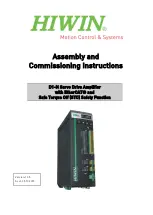
15 Software
15.1 Armonía Pro Audio Suite
Armonía Pro Audio Suite™ has been specifically designed
to be used with Bias Series amplifiers as an easy to use
configuring interface that allows system setting and
customization.
Communication between the software and the amplifier
is established via an RS-485 or Ethernet connection,
depending on the available ports on the units.
Armonía provides control and monitoring of a wide range
of amplifier functions, such as attenuation, mute, internal
temperature and voltage rail monitoring.
On Bias Series equiped with the DSP board Armonía offers
full control on all signal processing features, including input
and output equalization, alignment delays, FIR filters and
load impedance monitoring, etc.
Armonía is scalable: it allows control of a single Void amplifier
or a very large system containing many amplifiers. For large
fixed or touring installations, Armonía gives the operator the
ability to monitor and control all amplifiers in the system from
a single location, regardless of the amplifiers’ positions.
hub systems as well as a single hub and linear daisy-chaining.
A looped Ethernet topology is also permissible, which will
provide redundancy in the event of a network failure.
An amplifier system using an RS-485 network can either be
daisy-chained throughout or use the Void PowerHub as a
local switch.
This software has been designed to accept software plug-
ins to enable third-party product control.
Armonía is freely available on Void website: it can be
downloaded after signing up for the user forum: further
information is available on the software section of Void
website www.voidacoustics.com.
15.1.1 Networking
Void amplifiers can connect to a PC running Armonía in two
ways: with an RS-485 serial connection or via Ethernet.
Systems employing both categories of amplifiers may use
both methods simultaneously: an Ethernet network being
implemented for some amplifiers, and RS-485 for the others
(bear in mind that Ethernet is a faster communications
protocol than serial RS-485).
The range of network topologies which can be used in wiring
a real system varies between the two communications
methods.
Ethernet provides a slightly greater degree of freedom, as
standard IT network switches may be used to create multiple
Bias Series User Guide V1.0
Page 36
Содержание Bias V3
Страница 1: ...Bias V3 V9 User Guide V1 0...
Страница 8: ...4 Mechanical drawings FIGURE 2 Bias V3 mechanical drawings Bias Series User Guide V1 0 Page 2...
Страница 9: ...FIGURE 3 Bias V9 mechanical drawings Bias Series User Guide V1 0 Page 3...
Страница 46: ......
Страница 47: ......







































